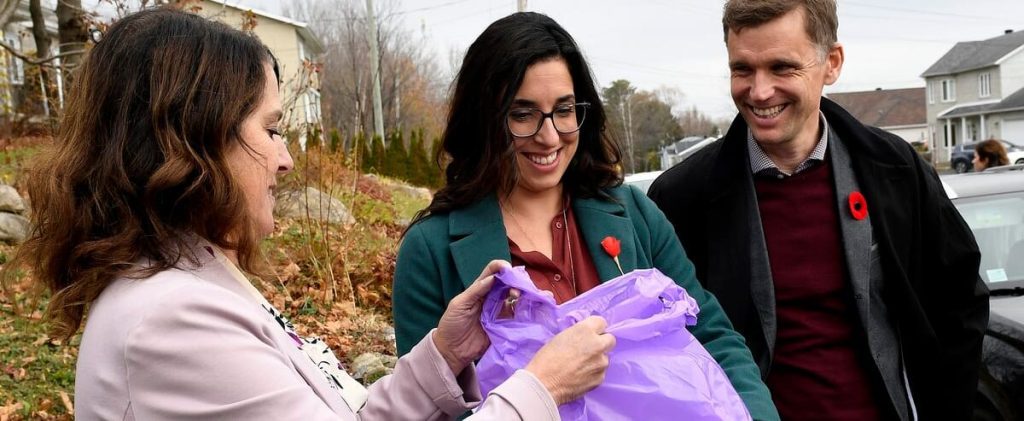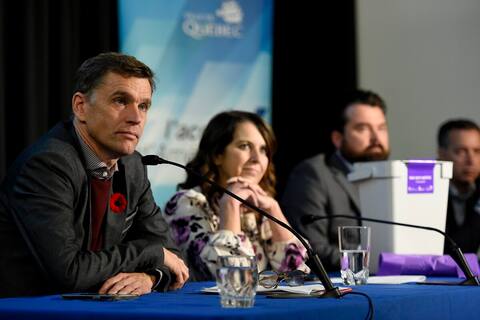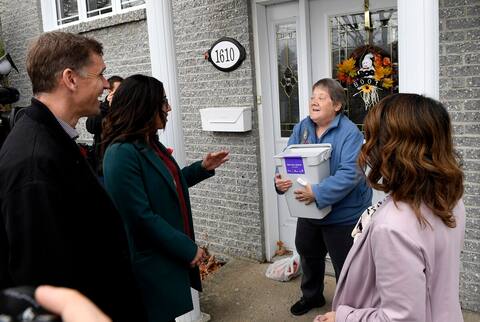
Let’s go for the collection of food items in the new cans and bags distributed by the city of Quebec… but only start in La Haute-Saint-Charles.
• Also Read: Everything you need to know about the Quebec City Agglomeration Biomethanation Center
• Also Read: Quebec: Your food waste will soon be collected from your garbage bin
The mayor, Bruno Marchand, and the vice-president of the executive committee, Marie-Josie Asselin, officially opened the collection of residues available at the new biomethanization center on Tuesday.
“Citizens, to your bags and your boxes! Proud to have started this planned collection since 2012, Ms. Launched Asselin.
Starting Wednesday, apartments in single-family or multi-unit buildings will receive a free small bin and purple bags at every door. This material is designed and manufactured in Quebec.
In La Haute-Saint-Charles, it starts now. Residents must now sort their food items (See the box)
Organic matter contains a lot of water, which is removed from combustion, which improves its performance, Ms. Asselin said.
The city chose to avoid the brown bin and third collection route. 50 truck trips per day or 13,000 per year and 3,150 tons of GHGs saved per year.
Mayor Marchand explained that this is also one less headache at a time of labor shortage.
Gradual implementation
After La Haute-Saint-Charles, other boroughs follow. We cannot deploy all over the city at the same time, Ms. Asselin explained.
We need to move gradually to give time for adjustments to be made, because there will certainly be some, the mayor advised.
“There will be challenges and problems. It won’t be perfect. But we move because we prefer imperfection to nothing. »
Quebec is “one of the few cities in Canada to make this prestigious choice,” Mr. Marchand said. Capital will have one of the largest biogas plants in North America. He says many cities have their sights set on what’s happening here to take inspiration from it.
The city has chosen to collect through colored bags, which is especially suitable for a dense city with many apartment buildings.
Citizens do not need to be bothered by the stench and white grass in the bins. And even by distributing the bags, the city saves $6.7 million a year.
Plastic bags are shredded and incinerated. But we are actively looking for a way to recycle them.
$210 million project
The biomethanization center project in Limoilou has a cost of $210 million, of which $150 million is the responsibility of the city, which expects to generate $100 million in revenue over 20 years from the sale of biogas.
Limoilou councilor Jackie Smith defended the options. “This greenwashing project will cost us all a lot and, first of all, the residents of Limoilou. The City has yet to understand that our neighborhood is not a dumping ground but a living environment. »
How does it work?
- Each residence receives a small kitchen bin and a roll of 48 purple bags, which are renewed free of charge every six months.
- Full purple bags are placed in the waste bin.
- They are taken to general collection, sorted at incineration and sent to biomethanation plant.
- Food residues are decomposed through biomethanization.
- The gas produced by biomethanation is sold.
- Plastic burns.
A question to ask
Can you eat it? where That’s part Anything edible?
If the answer is yes, the remains go into the purple bag.
Examples:
Leftover meat, vegetable or fruit clippings, coffee grounds, bones, egg or shellfish shells, nut shells, bread crusts, dairy products, etc.
Collection Expansion Calendar
November 2022
Haute-Saint-Charles
December 2022
Charlesburg
January 2023
Saint-Foy-Sillery-Cap-Rouge
February 2023
The Rivers, L’Ancienne-Lorette
March 2023
Beauport, Saint-Augustin-de-Desmours
April 2023
La Cite-Limoilou







More Stories
How List Acquisition Helps Your Political Campaign Become Successful
Four escaped cows were caught
A simple administrative decision? | Press